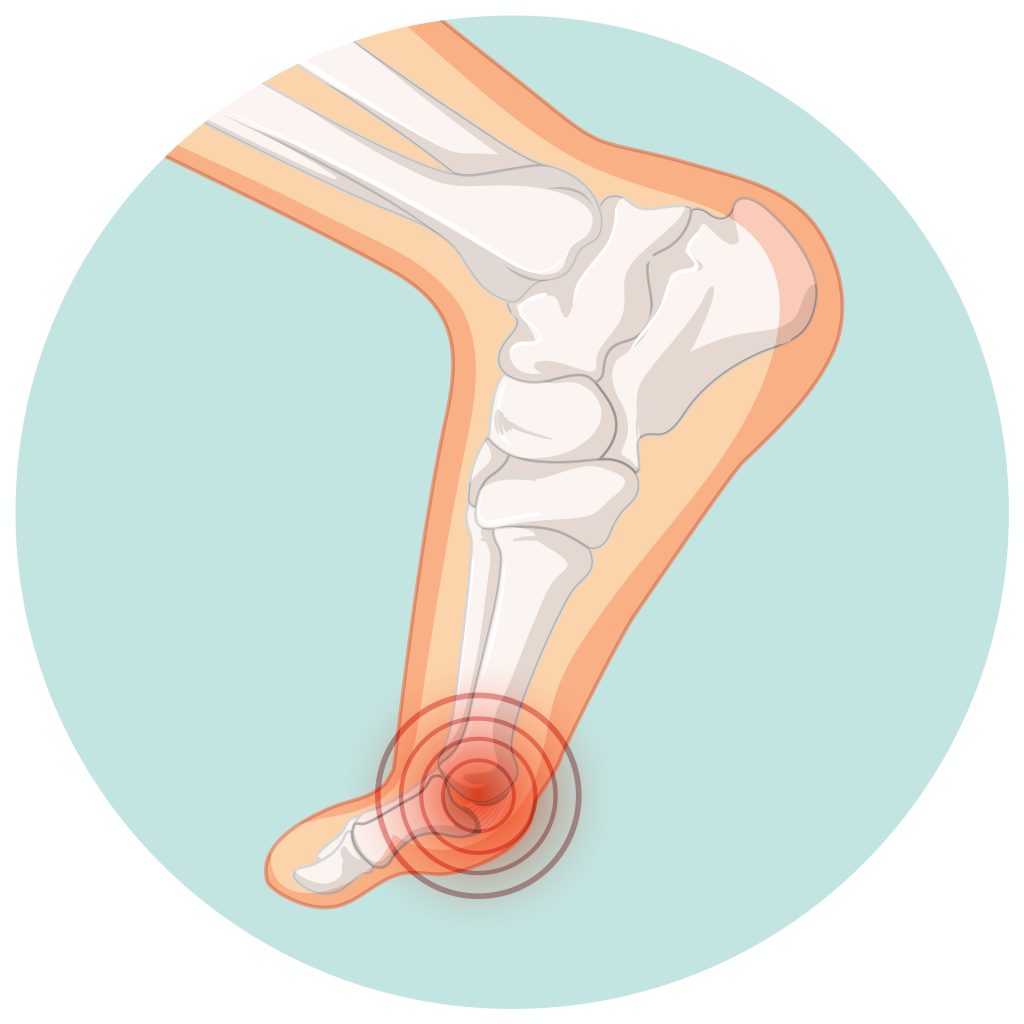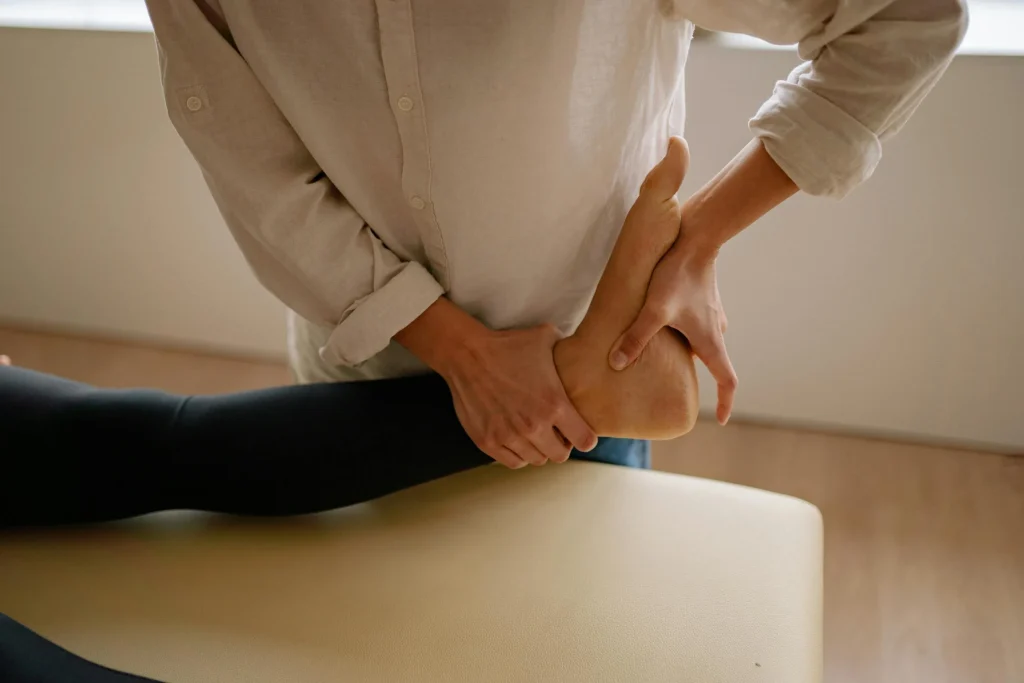Metatarsalgia Treatment Palm Beach Gardens, FL
Metatarsalgia (Ball of Foot Pain) Treatment at Motion Orthopaedic & Podiatry Institute
Motion Orthopedic & Podiatry Institute specializes in diagnosing and treating metatarsalgia, a common condition that causes pain in the ball of the foot. This condition often results from inflammation or injury to the metatarsal bones or the surrounding soft tissues. Whether you’re an athlete dealing with overuse injuries, spending long hours on your feet, or experiencing discomfort due to footwear or foot structure, our experienced team is here to provide personalized and effective treatment options to relieve pain, restore mobility, and prevent further complications.
What is Metatarsalgia?
Metatarsalgia is characterized by pain and inflammation in the ball of the foot, typically under the metatarsal heads. These are the five long bones located between the toes and the midfoot. The condition can affect one or multiple metatarsals and is often caused by excessive pressure, injury, or abnormal foot mechanics.
Metatarsalgia is not a specific disease but a symptom of an underlying issue. The pain may be sharp, aching, or burning and often worsens with standing, walking, or running. The condition can affect people of all ages and activity levels. However, it is widespread in athletes and those who engage in high-impact sports like running, basketball, or tennis.

Causes of Metatarsalgia
Several factors can contribute to the development of metatarsalgia, including:
- Foot Structure: Certain foot shapes or conditions, such as high arches, flat feet, or bunions, can alter how pressure is distributed across the foot. This can lead to increased stress on the metatarsal heads and contribute to the development of metatarsalgia.
- Improper Footwear: Wearing shoes that do not provide adequate support or cushioning, particularly high heels or shoes with narrow toe boxes, can increase pressure on the ball of the foot, leading to pain and inflammation.
- Overuse: Athletes and active individuals who engage in repetitive activities, such as running, jumping, or high-impact sports, are more likely to develop metatarsalgia due to the increased stress on the metatarsal bones.
- Age: As we age, the fat pads in the soles of our feet tend to thin, reducing the natural cushioning in the ball of the foot. This can lead to increased pressure on the metatarsals and a higher risk of developing metatarsalgia.
- Injury: Acute injuries, such as fractures, sprains, or overuse injuries, can cause inflammation in the metatarsal region and lead to ball-of-foot pain.
- Obesity: Carrying excess body weight places additional pressure on the feet, which can lead to increased strain on the metatarsal bones and contribute to the development of metatarsalgia.
- Other Foot Conditions: Conditions such as hammer toes, Morton’s neuroma, or calluses can cause changes in foot mechanics and increase pressure on the metatarsals, leading to pain and inflammation.
Symptoms of Metatarsalgia
The symptoms of metatarsalgia can vary in intensity depending on the underlying cause and the severity of the condition. Common symptoms include:
- Pain in the Ball of the Foot: The most prominent symptom of metatarsalgia is localized pain in the ball of the foot, usually around the metatarsal heads. The pain may be sharp, aching, or burning and can be felt during weight-bearing activities such as standing, walking, or running.
- Increased Pain During Activity: The pain often worsens with physical activity, particularly high-impact activities like running, jumping, or playing sports. Pain may also increase after long periods of standing or walking.
- Swelling or Inflammation: Some patients may experience mild swelling, redness, or warmth in the affected area, especially after prolonged activity.
- Numbness or Tingling: In some cases, patients may experience a tingling or numb sensation in the toes, which may be due to nerve compression or irritation near the metatarsal heads.
- Sensation of a Pebble in the Shoe: Many patients with metatarsalgia report feeling as though there is a pebble or lump under the ball of their foot, even though there is nothing physically present.
If you are experiencing any of these symptoms, it is essential to seek medical attention to identify the underlying cause and begin appropriate treatment.
Diagnosis of Metatarsalgia
At Motion Orthopaedic & Podiatry Institute, our specialists will thoroughly evaluate metatarsalgia and determine the underlying cause of your symptoms. The diagnostic process typically includes:
- Medical History and Physical Examination: Your doctor will review your medical history, including any previous injuries, surgeries, or chronic conditions that may be contributing to your foot pain. A physical examination of the foot will be conducted to assess the location of the pain, check for swelling or tenderness, and evaluate your foot structure and gait.
- Imaging Tests: In some cases, imaging tests such as X-rays, MRI, or ultrasound may rule out other conditions, such as fractures, stress injuries, or soft tissue damage. These tests can also help identify any structural abnormalities in the foot that may contribute to the development of metatarsalgia.
Once a diagnosis is confirmed, our team will work with you to develop a personalized treatment plan based on the severity of your condition and your individual needs.
Treatment Options for Metatarsalgia
At Motion Orthopaedic & Podiatry Institute, we offer a wide range of non-surgical and surgical treatment options for metatarsalgia. Our goal is to relieve pain, reduce inflammation, and improve foot function. Our treatment approach is tailored to each patient’s unique needs and condition.
Non-Surgical Treatment for Metatarsalgia
For most patients, non-surgical treatments are effective in managing the symptoms of metatarsalgia and promoting long-term healing. Some of the most common non-surgical treatment options include:
- Rest and Activity Modification: Reducing or modifying activities that place pressure on the ball of the foot, such as running, jumping, or standing for long periods, can help alleviate symptoms and allow the metatarsals to heal. Resting the foot is essential to prevent further irritation of the affected area.
- Ice and Anti-Inflammatory Medications: Applying ice to the ball of the foot several times a day can help reduce inflammation and relieve pain. Over-the-counter nonsteroidal anti-inflammatory drugs (NSAIDs), such as ibuprofen, can also be used to manage pain and reduce swelling.
- Footwear Modifications: Wearing shoes that provide adequate arch support, cushioning, and a roomy toe box can significantly reduce pressure on the ball of the foot. Patients are advised to avoid high heels, narrow shoes, and footwear with insufficient support.
- Custom Orthotics and Insoles: Custom orthotic inserts can be prescribed to provide extra cushioning and redistribute pressure away from the ball of the foot. These inserts are designed to correct foot alignment and reduce the stress placed on the metatarsal heads during weight-bearing activities.
- Physical Therapy: Physical therapy can help strengthen the muscles and tendons in the foot and lower leg, improving foot mechanics and reducing pain. A physical therapist will guide you through exercises designed to improve flexibility, strengthen the arch, and correct gait abnormalities.
- Padding and Metatarsal Pads: Padding the ball of the foot or using metatarsal pads can help offload pressure from the metatarsal heads and relieve pain. These pads are placed inside the shoe to cushion the affected area and provide additional support.

Advanced Treatment Options for Severe Cases
In cases where conservative treatments are not effective or if the condition is severe, advanced treatment options may be considered to provide relief and restore normal foot function.
- Corticosteroid Injections: For patients with severe pain that does not respond to other treatments, corticosteroid injections may be recommended to reduce inflammation and provide temporary relief. These injections are delivered directly into the affected area to reduce swelling and alleviate pain.
- Shock Wave Therapy: Extracorporeal Shock Wave Therapy (ESWT) is a non-invasive treatment that uses acoustic waves to stimulate healing in the damaged tissues. This therapy can be particularly effective for patients with chronic metatarsalgia or soft tissue injuries that have not responded to other treatments.
- Platelet-Rich Plasma (PRP) Therapy: PRP therapy involves using the patient’s own blood to create a concentrated solution of platelets, which are injected into the injured area to promote tissue regeneration and healing. PRP therapy may be recommended for patients with chronic pain or tendon injuries associated with metatarsalgia.
Surgical Treatment for Metatarsalgia
In rare cases where conservative treatments and advanced therapies are not effective, surgery may be necessary to correct the underlying issues causing metatarsalgia. Surgical options may include:
- Osteotomy: In cases where the metatarsal bones are abnormally long or misaligned, an osteotomy may be performed to shorten or realign the bones. This helps reduce pressure on the metatarsal heads and alleviates pain.
- Plantar Plate Repair: For patients with damage to the plantar plate, a surgical procedure may be required to repair the ligament and restore stability to the affected area.
- Removal of Bone Spurs or Calluses: In some cases, surgery may be required to remove bone spurs, calluses, or other abnormal growths that are contributing to the pain.
Our surgical team is highly experienced in performing minimally invasive procedures to treat metatarsalgia, ensuring that patients experience a quicker recovery and better outcomes.
Recovery and Prevention
The recovery process for metatarsalgia varies depending on the severity of the condition and the type of treatment used. For non-surgical treatments, most patients experience relief within a few weeks to a few months, provided they follow their treatment plan and avoid activities that exacerbate the condition.
For patients who undergo surgery, recovery may take several weeks to months, and physical therapy may be required to restore strength, flexibility, and mobility to the foot.
To prevent metatarsalgia from recurring, it is important to:
- Wear Proper Footwear: Choose shoes that provide adequate arch support, cushioning, and a roomy toe box. Avoid high heels or shoes that place excessive pressure on the ball of the foot.
- Use Orthotic Inserts: If you have foot abnormalities or high arches, custom orthotics can help redistribute pressure and reduce the risk of developing metatarsalgia in the future.
- Maintain a Healthy Weight: Maintaining a healthy weight can reduce the amount of pressure placed on the feet, lowering the risk of developing ball-of-foot pain.
- Stretch and Strengthen the Foot: Regular stretching and strengthening exercises for the foot and lower leg can improve flexibility and reduce the risk of injury.
Why Choose Motion Orthopaedic & Podiatry Institute for Metatarsalgia Treatment?
At Motion Orthopaedic & Podiatry Institute, we are dedicated to providing comprehensive, patient-centered care for individuals suffering from metatarsalgia. Here’s why patients choose us:
- Experienced Specialists: Our team of board-certified podiatrists and orthopedic specialists has extensive experience in diagnosing and treating metatarsalgia using both non-surgical and advanced treatment options.
- Personalized Treatment Plans: We understand that every patient is unique, which is why we create customized treatment plans tailored to your specific needs and lifestyle.
- State-of-the-Art Facility: Our clinic is equipped with the latest technology and treatment options to ensure you receive the best possible care in a comfortable and supportive environment.
If you’re experiencing pain or discomfort in the ball of your foot, the team at Motion Orthopedic & Podiatry Institute is here to help. Contact us today to schedule a consultation and learn more about our comprehensive metatarsalgia treatment options.
- Orthopedic Surgery
- Podiatry Care
- Regenerative Medicine
- Sports Medicine
- Vein Treatment
- Arthroscopic & Joint Replacement Surgery:
- Knee Pain
- Shoulder Pain
- Hip Pain
- Sports Injuries
- Tendonitis and Bursitis
- Carpal Tunnel Syndrome
- Trigger Finger
- Wound Care
- Concierge Orthopaedic Services